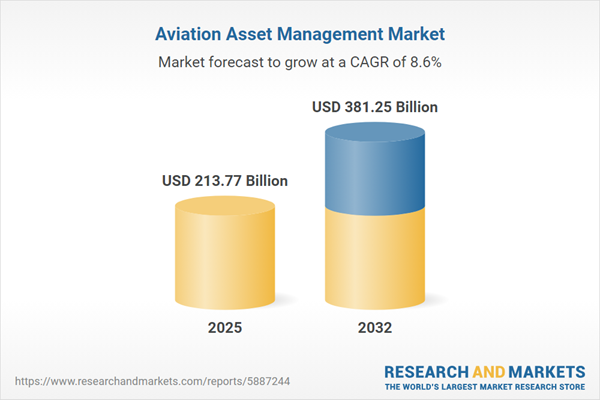Speak directly to the analyst to clarify any post sales queries you may have.
The aviation asset management market is undergoing substantial transformation as operators, lessors, and service providers realign strategies in response to a dynamic regulatory and technological landscape. Senior decision-makers must evaluate how industry trends and emerging technologies are redefining risk, operational efficiency, and competitive positioning in aviation asset management.
Market Snapshot: Aviation Asset Management Market Growth and Trends
The Aviation Asset Management Market grew from USD 196.94 billion in 2024 to USD 213.77 billion in 2025. It is expected to continue growing at a CAGR of 8.60%, reaching USD 381.25 billion by 2032.
This market is driven by a convergence of globalization, digital integration, and evolving sustainability mandates. Fleet expansion, retrofits, and collaborative supplier models are reshaping value creation and operational risk. Asset managers navigate increasingly complex regulatory regimes and seek efficiencies across all phases of the aviation asset lifecycle.
Scope & Segmentation: Unlocking Precision in Aviation Asset Management
- Service Types: Asset Leasing; Engineering Services; Maintenance Repair Overhaul (including Base, Component, and Line Maintenance); Spare Parts Supply.
- Asset Classes: Airframes; Auxiliary Power Units; Avionics (encompassing Communication, Flight Control, Navigation, and Surveillance Systems); Engines (Turbofan, Turbojet, Turboshaft); Landing Gear.
- End Users: Airlines; Government & Defense; Leasing Companies; MRO Providers; OEMs.
- Aircraft Types: Business Jet; Narrowbody; Regional Jet; Turboprop; Widebody.
- Applications: Aftermarket; OEM.
- Regions: Americas (United States, Canada, Mexico, Brazil, Argentina, Chile, Colombia, Peru); Europe, Middle East & Africa (United Kingdom, Germany, France, Russia, Italy, Spain, Netherlands, Sweden, Poland, Switzerland, United Arab Emirates, Saudi Arabia, Qatar, Turkey, Israel, South Africa, Nigeria, Egypt, Kenya); Asia-Pacific (China, India, Japan, Australia, South Korea, Indonesia, Thailand, Malaysia, Singapore, Taiwan).
- Leading Companies: AerCap Holdings N.V.; Avolon Holdings Limited; SMBC Aviation Capital Limited; BOC Aviation Limited; Air Lease Corporation; BBAM L.P.; Aviation Capital Group LLC; Nordic Aviation Capital A/S; Aircastle Limited; Macquarie AirFinance Limited.
Key Takeaways for Aviation Asset Managers
- Shifting toward predictive maintenance and data-driven insights is vital for optimizing asset performance and enhancing lifecycle transparency.
- Collaborative industry ecosystems, including data-sharing networks, provide leverage for performance benchmarking and inventory optimization.
- Decarbonization efforts—such as green retrofits and tracking alternative fuels—are becoming central to operations, with direct implications for asset valuation and long-term planning.
- Stakeholders are moving beyond risk mitigation, viewing asset management as a strategy for competitive differentiation and holistic stewardship.
- Advanced analytics and digital twins are enabling faster, more resilient adaptation to supply chain changes, regulatory pressures, and evolving fleet requirements.
- Strategic supplier partnerships and diversification are increasingly important to address varying regional regulations and supply availability challenges.
Tariff Impact: United States Trade Actions and Supply Chain Response
Recent U.S. tariffs on aviation components and services have raised the cost of imported spare parts and specialized overhauls, necessitating new approaches in inventory management and long-term sourcing. Operators are carefully weighing trade compliance, alternative sourcing agreements, and collaborative procurement to limit exposure. Tariff-driven customs delays highlight the importance of predictive supply chain tools to ensure asset availability and timely maintenance.
Methodology & Data Sources
This report applies a rigorous approach, synthesizing primary input from industry leaders, MRO providers, lessors, and regulators. Data is validated through quantitative analysis, technical literature review, and expert peer feedback, ensuring reliable insights and actionable recommendations.
Why This Report Matters for Senior Leaders
- Gain a detailed framework to align asset management operations with shifting regulatory, financial, and technological landscapes.
- Support strategic planning by leveraging actionable segmentation, regional trends, and technology adoption insights tailored to your business context.
- Anticipate emerging risks from tariffs, sustainability mandates, and supply chain variability, enabling informed decision-making and investment prioritization.
Conclusion
Amid technological advances, tariff shifts, and growing sustainability requirements, aviation asset management is more strategic than ever. This report offers decision-makers a clear, actionable guide to drive performance, resilience, and long-term growth.
Additional Product Information:
- Purchase of this report includes 1 year online access with quarterly updates.
- This report can be updated on request. Please contact our Customer Experience team using the Ask a Question widget on our website.
Table of Contents
3. Executive Summary
4. Market Overview
7. Cumulative Impact of Artificial Intelligence 2025
Companies Mentioned
The companies profiled in this Aviation Asset Management market report include:- AerCap Holdings N.V.
- Avolon Holdings Limited
- SMBC Aviation Capital Limited
- BOC Aviation Limited
- Air Lease Corporation
- BBAM L.P.
- Aviation Capital Group LLC
- Nordic Aviation Capital A/S
- Aircastle Limited
- Macquarie AirFinance Limited
Table Information
| Report Attribute | Details |
|---|---|
| No. of Pages | 187 |
| Published | November 2025 |
| Forecast Period | 2025 - 2032 |
| Estimated Market Value ( USD | $ 213.77 Billion |
| Forecasted Market Value ( USD | $ 381.25 Billion |
| Compound Annual Growth Rate | 8.6% |
| Regions Covered | Global |
| No. of Companies Mentioned | 11 |









